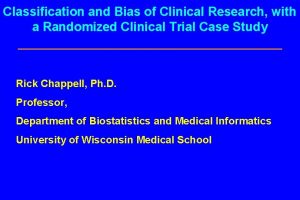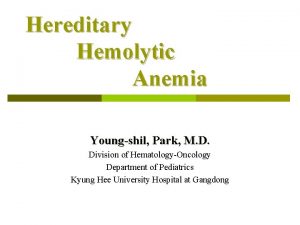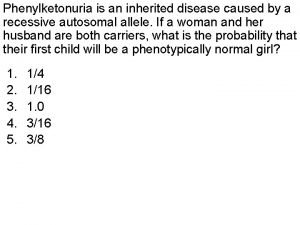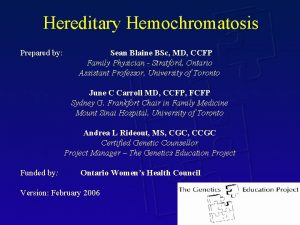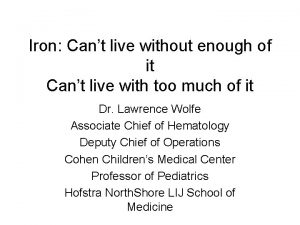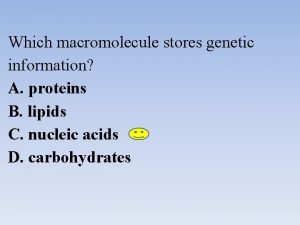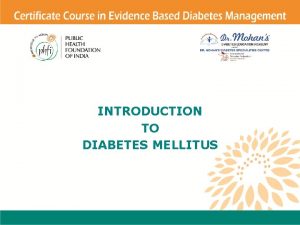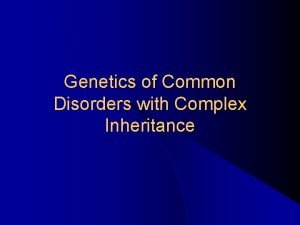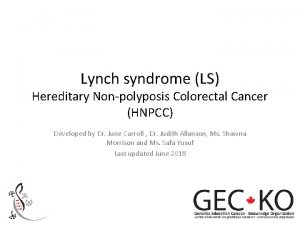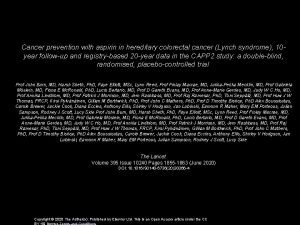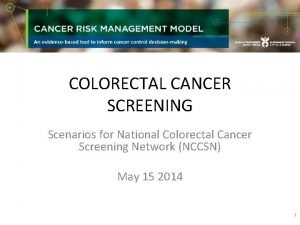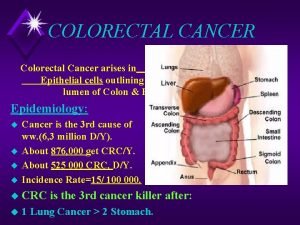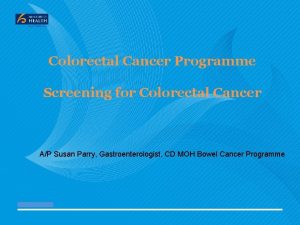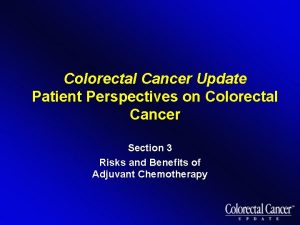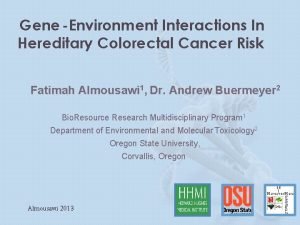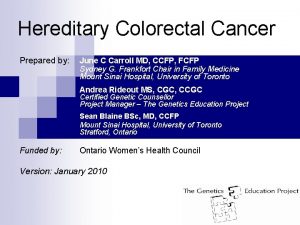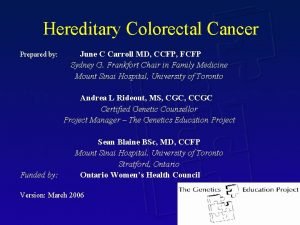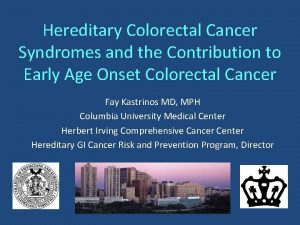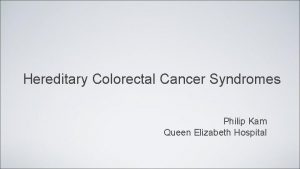Emerging Concepts in Colorectal Cancer Hereditary NonPolyposis Cancer























- Slides: 23

Emerging Concepts in Colorectal Cancer: Hereditary Non-Polyposis Cancer (Lynch Syndrome) Short Presentations in Emerging Concepts (SPEC)

Colorectal Cancer: Molecular Pathways

Molecular pathways in colon cancer

What value is there in recognizing MSI-H colorectal tumors? 1. Prognosis 2. Response to chemotherapy 3. Screen for Lynch Syndrome (HNPCC)

Prognostic significance of MSI-H in sporadic CRC Gryfe, R et al, NEJM 2000; 342: 69 -77

Tumor Microsatellite-Instability Status as a Predictor of Benefit from Fluorouracil-Based Adjuvant Chemotherapy for Colon Cancer Ribic, C. R. , et al. New Engl J Med 349: 247 -57 (2003)

Colorectal Cancer: Molecular Pathways

Lynch Syndrome (HNPCC) • HNPCC – Hereditary Non-Polyposis Colon Cancer – Historically: • Lynch Syndrome I – restricted to colon • Lynch Syndrome II – colon and extracolonic sites • Accounts for 3 -4% of all colon cancers • Accounts for 15 -20% of MSI tumors • Inherited predisposition to many different cancers, including colon cancer

Lynch Syndrome: Cardinal Features • Autosomal dominant inheritance • Gene penetrance for CRC of 85 -90% – Develop CRC at an early age - 45 yrs – Most CRC (70%) proximal to splenic flexure – Multiple CRC’s common - synchronous and metachronous – Prognosis better than sporadic CRC – Associated pathologic features • Increased risk for other malignancies

Lynch Syndrome: Extracolonic Tumors Site Features Endometrium Second most common Stomach Older generations Small bowel Risk 25 X in HNPCC Hepatobiliary tract 5% risk Ureter and pelvis 14 -20% risk Skin Muir-Torre Syndrome Pancreas Trend for increase Brain GBM in some HNPCC (Turcot’s) Hematologic Case reports Soft tissue Case reports Larynx Case report

Lynch Syndrome: Cumulative cancer risk in LS carriers by age 70 Site of tumor Finnish population (%) HNPCC families (%) Colon/rectum 1. 6 82 Endometrium 1. 3 60 Stomach 0. 8 13 Ovary 1. 3 12 Bladder, urethra 0. 7 4. 0 Brain 0. 9 3. 7 Kidney 0. 8 3. 3 Biliary tract, gallbladder 0. 2 2. 0 Aarnio M, et al, Int J Cancer 1999; 81: 214 -218.

Lynch Syndrome: Cumulative cancer risk by age 70 By age 70, the risk for endometrial cancer exceeds that of colon cancer: Site Incidence by age 70 in women Endometrium Colon 60% 54% Aarnio, M et al, Int J Cancer 1999; 81: 214 -18

Lynch Syndrome: Pathological features of colorectal cancer • • • Poor differentiation Increased signet cells Medullary features Peritumoral lymphocyte infiltration Crohn’s like reaction Tumor infiltrating lymphocytes (TIL’s)

How to recognize Lynch Syndrome • Amsterdam Criteria – Clinical guidelines for when to suspect Lynch Syndrome • Bethesda Guidelines – Guidelines for when to do MSI testing • Screen all new colon cancers?

Lynch Syndrome - Amsterdam Criteria II (1999) • At least three family members with a Lynch Syndromeassociated cancer, two of whom are first-degree relatives. • At least two generations represented. • At least 1 individual younger than 50 years at diagnosis. • FAP should be excluded. • Tumors should be verified by pathologic examination. Vasen et al, Gastroenterology 1999; 116: 1453 -56

Revised Bethesda Guidelines for testing colorectal tumors for MSI - 2004 Tumors from individuals should be tested for MSI in the following situations: 1. Colorectal cancer in a patient less than 50 years of age. 2. Presence of synchronous, metachronous colorectal, or other HNPCC associated tumors, regardless of age. 3. Colorectal cancer with the MSI-H histology diagnosed in a patient less than 60 yr. 4. Colorectal cancer diagnosed in one or more first-degree relatives with an HNPCC-related tumor, with one of the cancers being diagnosed under age 50 yr. 5. Colorectal cancer diagnosed in two or more first- or second-degree relatives with HNPCC-related tumors, regardless of age. Umar, et al. , J Natl Cancer Inst 2004; 96: 261 -8

Lynch Syndrome: Mismatch repair gene mutations Gene Frequency in HNPCC MSH 2 ~39% MLH 1 ~32% PMS 1 Rare PMS 2 ~14% GTBP/MSH 6 ~14% Other ?

Immunohistochemistry for MMR Protein Expression MLH 1 MSH 6 Loss of expression Due to mutation Due to methylation MSH 2 PMS 2 Lynch Syndrome Sporadic MSI CRC

Universal screening Recommendations from the EGAPP Working Group: genetic testing strategies in newly diagnosed individuals with colorectal cancer aimed at reducing morbidity and mortality from Lynch syndrome in relatives Evaluation of Genomic Applications in Practice and Prevention Working Group Genetics in Medicine 11: 35 -41 (2009)

Significance of Lynch Syndrome 1. The patient is at risk for other cancers and needs appropriate surveillance. 2. The patient’s relatives will also be at increased risk if they carry the same mutation, and will need appropriate surveillance. 3. Relatives can be tested to determine their risk, and level of surveillance.

Summary • MSI-H tumors account for about 20% of all colon cancers. • Lynch Syndrome tumors account for 15 - 20% of MSI-H colon cancers, and about 4% of all colon cancers. • MSI-H colon cancers are biologically distinctive in their behavior. • MSI testing should be performed if indicated by Bethesda Guidelines. • MSI testing can be performed on fixed tissue. • Patients with MSI-H tumors are candidates for genetic counseling and further genetic testing.

Selected Resources Lynch HT, et al. Hereditary nonpolyposis colorectal carcinoma and HNPCC-like families: problems in diagnosis, m surveillance, and management. Cancer. 2004 ; 100: 53 -64. EGAPP Working Group. Recommendations from the EGAPP Working Group: genetic testing strategies in newly diagnosed individuals with colorectal cancer aimed at reducing morbidity and mortality from Lynch syndrome in relatives. Genet Med. 2009 ; 11(1): 35 -41. Vasen HF, Blanco I, Aktan-Collan K, et al. Revised guidelines for the clinical management of Lynch Syndrome (HNPCC): recommendations by a group of European experts. Gut. 2013; 62(6): 812 -823.

Additional Free Resource for CAP Members NOTE: please remove this page before presenting. CAP Member Exclusive: CAP Pathology Resource Guides Focused on a specific hot-topic technology, these comprehensive guides highlights current resources, select journal articles, as well as CAP and non-CAP educational opportunities. And don’t miss the “Insights From Early Adopters” section in each guide to gain perspective from pioneering colleagues. AVAILABLE NOW: • Molecular Pathology (single gene test, small panel) • Genomic Analysis (large panel, exome, genome) Learn more: go to cap. org and type Pathology Resource Guides in the “search” field located at the top of your screen. “An outstanding overview of basic materials, including the technology and links to a number of individuals and centers that can assist. ” “Extremely well done, of high practical and educational value. ”
 Colorectal cancer
Colorectal cancer Amsterdam criteria
Amsterdam criteria Colorectal cancer drug trial
Colorectal cancer drug trial Ann lyons colorectal surgeon
Ann lyons colorectal surgeon Colon
Colon Osmotic fragility
Osmotic fragility Linkage group in drosophila
Linkage group in drosophila Stores hereditary information
Stores hereditary information Pku is an inherited disease caused by a recessive allele
Pku is an inherited disease caused by a recessive allele Change in hereditary features over time
Change in hereditary features over time Earliest childhood memories of rizal
Earliest childhood memories of rizal Hereditary hemochromatosis inheritance pattern
Hereditary hemochromatosis inheritance pattern Disadvantages of indirect injection
Disadvantages of indirect injection Hereditary polyposis
Hereditary polyposis Hereditary persistence of fetal hemoglobin
Hereditary persistence of fetal hemoglobin What is hereditary spherocytosis
What is hereditary spherocytosis Hereditary spherocytosis
Hereditary spherocytosis Is intelligence hereditary
Is intelligence hereditary Which macromolecule stores energy
Which macromolecule stores energy The change in the hereditary features over time
The change in the hereditary features over time C peptide low
C peptide low Is schizophrenia genetic
Is schizophrenia genetic Hereditary spherocytosis
Hereditary spherocytosis Is schizophrenia genetic
Is schizophrenia genetic


